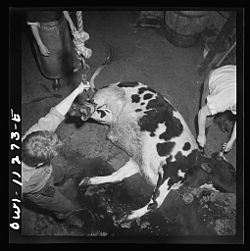The slaughterhouse industry has been around for thousands of years since humanity first started, but the major slaughterhouse industries such as tyson have been around for only a few decades, but unlike the slaughterhouses in the early 1500, The new slaughterhouses process there meat at a fast pace, in fact a slaughterhouse in the 21st century is supposed to process 400 animals an hour, which is equivalent to about 5,000 animals killed a,/strong> day in one slaughterhouse, with so many animals being processed in the slaughterhouses, workers there don't have the time to make sure that every animal is clean and doesn't have anything on it, such as dead rats and flies, some of the places that have been sued for such incidents are Mcdonalds and KFC, KFC was sued by a woman who found a small chicken deep fried whole, but he most popular place that has been sued on many occasions is Mc Donalds, such as the time one woman found a dead rat in her salad at Mcdonalds. also about half of the animal can be turned into meat. About some parts of an animal are waste, and the remaining half of the animal is turned into animal products such as leather, soaps, candles, and animal glue, Refrigeration allowed meat from the slaughterhouse to be preserved for longer periods. This led to the concept as the slaughterhouse as a freezing works. Prior to this, canning was an option, Freezing works are common in New Zealand, Australia and South Africa. The countries where meat is exported for a substantial profit the freezing works were built near docks, or near transport infrastructure.
Tweet| Cows dead | Date |
|---|---|
| 68 million dead | 2013 |
| 60 million dead | 2010 |
| 47 million dead | 2004 |
| Cows dead | Date |
|---|---|
| 34 million dead | 1999 |
| 31 million dead | 1984 |
| 20 million dead | 1974 |


Most countries have laws in regard to the treatment of animals at slaughterhouses. In the United States, there is the Humane Slaughter Act of 1958, a law requiring that all swine, sheep, cattle , and horses be stunned unconscious with application of a stunning device by a trained person before being hoisted up on the line. There is some debate over the enforcement of this act, This act, like those in many countries, exempts slaughter in accordance to religious law, such as kosher shechita and dhabiha halal, Most strict interpretations of kashrut require that the animal be fully sensible when it's carotid artery is cut, The novel The Jungle detailed unsanitary conditions in slaughterhouses and the meatpacking industry during the 1800s. This led directly to an investigation commissioned directly by President Theodore Roosevelt, and to the passage of the Meat Inspection Act and the Pure Food and Drug Act of 1906, which established the Food and Drug Administration. A much larger body of regulation deals with the public health and worker safety regulation and inspection.

The standards and regulations governing slaughterhouses vary considerably around the world. In many countries the slaughter of animals is regulated by custom and tradition rather than by law. In the non Western world, including the Arab world, the Indian sub continent, etc., both forms of meat are available one which is produced in modern mechanized slaughterhouses, and the other from local butcher shops, In some communities animal slaughter may be controlled by religious laws, most notably halal for Muslims and kashrut for Jewish communities. These both require that the animals being slaughtered should be conscious at the point of death, and as such animals cannot be stunned prior to killing. This can cause conflicts with national regulations when a slaughterhouse adhering to the rules of religious preparation is located in some Western countries. In Jewish law, captive bolts and other methods of pre-slaughter paralysis are generally not permissible, due to it being forbidden for an animal to be stunned prior to slaughter. Various halal food authorities have more recently permitted the use of a recently developed fail-safe system of head only stunning where the shock is non-fatal, and where it is possible to reverse the procedure and revive the animal after the shock. The use of electronarcosis and other methods of dulling the sensing has been approved by the Egyptian Fatwa Committee. This allows these entities to continue their religious techniques while keeping accordance to the national regulations, In many societies, traditional cultural and religious aversion to slaughter led to prejudice against the people involved. In Japan, where the ban on slaughter of livestock for food was lifted only in the late 19th century, the newly found slaughter industry drew workers primarily from villages of burakumin, who traditionally worked in occupations relating to death, In some parts of western Japan, prejudice faced by current and former residents of such areas is still a sensitive issue. Because of this, even the Japanese word for slaughter is deemed politically incorrect by some pressure groups as its inclusion of the kanji for kill supposedly portrays those who practice it in a negative manner, Some countries have laws that exclude specific animal species or grades of animal from being slaughtered for human consumption, especially those that are taboo food. The former Indian Prime Minister Atal Bihari Vajpayee suggested in 2004 introducing legislation banning the slaughter of cows throughout India, as Hinduism holds cows as sacred and considers their slaughter unthinkable and offensive. This was often opposed on grounds of religious freedom. The slaughter of cows and the importation of beef into the nation of Nepal are strictly forbidden.